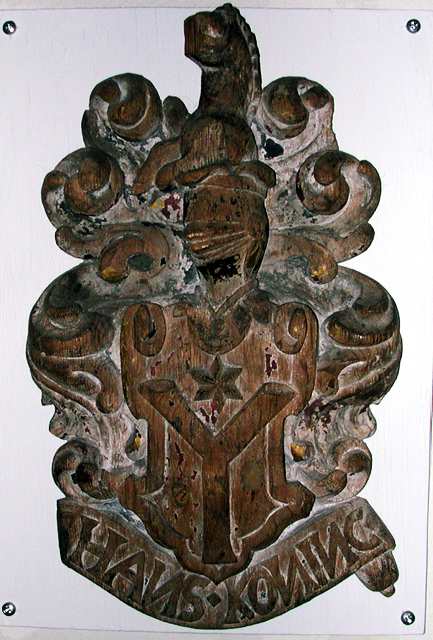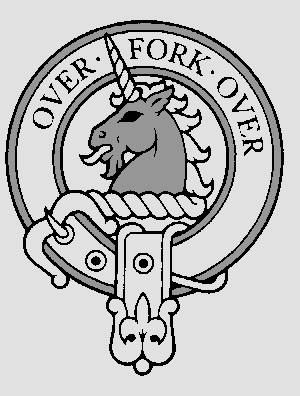| Ancestor
Chart
John Cunningham
or Hans Køning (ca. 1575 - 1651)
John Cunningham
was born abt. 1575 at the manor Barns, The East Neuk of Fife,
Scotland. It's presumed that his baptism was in Kirk of Crail in Fife.
He died late 1651 at Gerdrup, Zealand, Denmark. His burial was on 9th
December 1651 at the Church in Eggeslevmagle, Zealand. John was probably
an illegitimate son of Alexander Cunningham,
Laird of West Barns and Christiane Wood.
(John/Hans was naturalised by his father in 1596). John married first
time an unknown woman (who might have died in childbirth) 9 march, 1607
in Helsingør, Denmark. King Christian IV of Denmark honoured
the wedding by his presence.
John/Hans married the second time, Ellen
Clausdatter Hundermark, 4 Sep. 1625 at Bodøgaard in Nordland,
Norway. Ellen was a widow and noble lady from Denmark. She died in Oct.
1633.
John/Hans also had a mistress. A woman
from Bergen who died in 1674. He had two children with this woman:
1. Jakob Hansen Cunningham, b. 1619, d. 24 Mar. 1680, Horslunde, Denmark.
Natural, but illegitimate son.
2. Christine
Hansdatter Cunningham, b. abt. 1620, d. aft. 1692, natural,
but illegitimate daughter.

From Tromsø Museum. Photo: Arnstein
Rønning.
 | John
had his service for the English King Jacob I. (Jacob 6. in Scotland), until 1603
when King Jacob sent a recommendation ("by our request and recommendation")
to his brother in law, the Danish- Norwegian King Christian IV, were he recommended
John to become the leader for an expedition to Greenland and Northern Norway.
On 4th May 1605 three ship were leaving Copenhagen on their expedition to Greenland.
The ships name was "Trost", "Løven" and "Marekatten".
John was the Captain on the ship "Trost". On the next expediton to Greenland,
John was the Captain on the ship "Løven". After this expeditions
John had his service in the Danish-Norwegian navy. For
his outstanding naval service in Danish-Norwegian coastal waters, the Scotsman
John Cunningham was granted a post as District Governor of Vardøhus and
Finnmark in Arctic Norway. With its unprotected eastern borders, facing Russia
and Sweden, Finnmark was the northern-most outpost of the dual monarchy. Here
he reigned as District Governor for 32 years, from 1619 to 1651. There are in
fact few individuals in all of Norway (and Denmark) who, as local officials, have
represented the royal court for so many years. Cunningham’s
efforts are all the more remarkable when we realize that his period as District
Governor coincided with great hardships and reports of famine among the populace.
Cunningham’s paternalism for his subordinates, and his true concern for them,
resulted in great antagonism among the merchants. |
The
merchants’ complaints to the king did not change anything, however. Leading
to enormous challenges of rule in Finnmark, too, was the rapidly expanding integration
into the Danish-Norwegian realm of the native Sami people.
Within the conglomerate
states in a process of formation and integration, the conflicting ethnic identities
must have caused quite complicated issues. As a collective group, the Sami posed
a threat to the territorial expansion of Denmark-Norway, its state-building and
its endeavours to spread civilization in the outpost of Europe. It has been rumoured
that the Danish-Norwegian king Christian IV (1577-1648) appointed John Cunningham
to hunt down witches and prevent the spread of witchcraft in the region. The king
was apparently pleased with how readily Cunningham fulfilled his mission. The
Scotsman John (Hans) Cunningham was appointed District Governor (lensmann) of
Vardøhus Len in the very north of Norway early in the springtime of 1619.
Remaining in this position for 32 years is in itself an evidence for his success
in carrying out the Crown's territorial, political and economical policy in the
north of Norway. His solid position was never even seriously challenged. In this
Cunningham stands out among the District governors in Norway, both predecessors
and successors. Being the King's (Christian IV) most faithful servant, he was
allowed to govern the county and, with few restrictions from Copenhagen, exercised
authority almost like a feudal lord. As district governor of Finnmark he even
chose the appropriate name Hans Køning (cf. king). On the other hand, the
relation between the state centre and the northern province provided a dynamic
interplay. He used all available channels to make his demands and his proposals
known. These were thought so appropriate that the Crown sought to fit his proposals
into existing law and policy. Cunningham came to serve the Danish-Norwegian king
Christian IV when the king's brother-in-law, the demon-obsessed Scottish king,
James VI, recommended the man to him. During Cunningham's time in Northern-Norway
there were more than 50 brutal witch-trials in Finnmark. Various sources and contemporary
accounts lead us to believe that some of the blame for the brutal Finnmark witch
persecutions falls on Cunningham himself. It was reported in a memoir from the
1660s that he was sent to Finnmark, among other things, to wage war upon witchcraft
in the northern regions. Perhaps Cunningham's Scottish background can explain
his success as a local governor and witch hunter?

Eggeslevmagle church near Korsør,
Denmark. Photo: Hans A. Rosbach.
More
info later....1)
1)
Rev. Walter Wood: The East Neuk of Fife (1. ed. 1862),
Herredags-Dombog 1651-53, fol. 72v-80v, Rigsarkivet, Kbh
Grønlands hist. Mindesmærker III, 670 ff.
H. D. Lind, Kristian IV og hans menn på Bremerholm 1889 s. 166
f.
G.F.Heiberg: Slægten Heiberg, Oslo(Cammermeyers boghandel) 1907
R. Hagen, Universitetsbiblioteket v/UiT, 1999,, 2002 og 2004. + (appendiks
ved Louise Yeoman)
Collins Samlinger, Embedskalenderen bind V, IX og X
Arnstein Rønnings nettsted http://heraldikk.blogspot.com/
|



